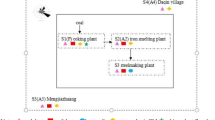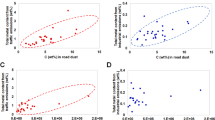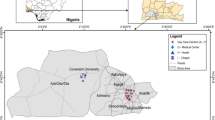Abstract
The explosion and collapse of the World Trade Center (WTC) was a catastrophic event that produced an aerosol impacting many residents, workers, and commuters after September 11, 2001. In all, 12 bulk samples of the settled dust were collected at indoor locations surrounding the epicenter of the disaster, including one sample from a residence that had been cleansed and was once again occupied. Additionally, one sample was collected from just outside a fifth story window on the sill. These samples were analyzed for many components, including inorganic and organic constituents as well as morphology of the various particles. The results of the analyses for persistent organic pollutants on dusts that settled at indoor locations are described herein, including polycyclic aromatic hydrocarbons, polychlorinated biphenyls, and select organo-chlorine pesticides. The Σ86-PCB concentrations, comprising less than one part per million by mass of the bulk in the two samples analyzed, indicated that PCBs were of limited significance in the dust that settled at indoor locations across lower Manhattan. Likewise, organo-chlorine pesticides, Hexachlorobenzene, Heptachlor, 4,4′-DDE, 2,4′-DDT, 4,4′-DDT and Mirex were found at even lower concentrations in the bulk samples. Conversely, Σ37-PAHs comprised up to 0.04% (<0.005–0.036%) by mass of the bulk indoor dust in the 11 WTC impacted bulk indoor samples. Analysis of one sample of indoor dusts collected from a vacuum cleaner of a rehabilitated home shows markedly lower PAH concentrations (<0.0005 mass%), as well as differing relative contributions for individual compounds. In addition to similar concentrations, comparison of PAH concentration patterns (i.e. chemical fingerprints) shows that dusts that settled indoors are chemically similar to previously measured WTC dusts found at outdoor locations and that these PAH analyses may be used in identifying dusts of WTC origin at indoor locations, along with ascertaining further needs for cleaning.
This is a preview of subscription content, access via your institution
Access options
Subscribe to this journal
Receive 6 print issues and online access
$259.00 per year
only $43.17 per issue
Buy this article
- Purchase on Springer Link
- Instant access to full article PDF
Prices may be subject to local taxes which are calculated during checkout





Similar content being viewed by others
References
Brunciak P.A., Dachs J., Gigliotti C.L., Nelson E.D., and, Eisenreich S.J . Atmospheric polychlorinated biphenyl concentrations and apparent degradation in coastal New Jersey. Atmos Environ 2001: 35: 3325–3339.
Claudio L . Environmental aftermath. Environ Health Perspect 2001: 109: A528–A537.
Gigliotti C.L., Dachs J., Nelson E.D., Brunciak P.A., and, Eisenreich S.J . Polycyclic aromatic hydrocarbons in the New Jersey coastal atmosphere. Environ Sci Technol, 2000: 34: 3547–3554.
Kitsa V., Lioy P.J., Chow J.C., Watson J.G., Shupack S., Howell T., and, Sanders P . Aerosol Sci Technol 1992: 17: 213–229.
Landrigan P.K . Health Consequences of the 11 September 2001 attacks. Environ Health Perspect 2001: 109(11): A514–A515.
Lioy P.J., Chen L.C., Weisel C., Millette J., Vallero D., Eisenreich S., Offenberg J., Buckley B., Turpin B., Zhong M., Cohen M.D., Yang I., Stiles R., Johnson W., and, Alimokhtari S . Characterization of the dust/smoke aerosol that settled east of the World Trade Center (WTC) in Lower Manhattan after the collapse of the WTC 11 September 2001. Environ Health Perspect 2002: 110: 703–714.
Manuel J.S . NIEHS responds to the World Trade Center Attacks. Environ Health Perspect 2001: 109(11): A526–A527.
Mullins M.D., PCB workshop. US EPA Large Lakes Research Station, Gross Ile, MI, 1985.
Naumova Y.Y., Eisenreich S.J., Turpin B.J., Weisel C.P., Morandi M.T., Colome S.D., Totten L.A., Stock T.H., Winer A.M., Alimokhtari S., Kwon J., Shendell D., Jones J., Maberti S., and, Wall S.J. Polycyclic aromatic hydrocarbons in the indoor and outdoor air of three cities in the U.S. Environ Sci Technol 2002: 36: 2552–2559.
Offenberg J.H., and, Baker J.E . Aerosol size distributions of polycyclic aromatic hydrocarbons in urban and over-water atmospheres. Environ Sci Technol 1999: 33: 3324–3331.
Offenberg J.H., Eisenreich S.J., Chen L.C., Cohen M.D., Chee G., Prophete C., Weisel C., and, Lioy P.J . Persistent organic pollutants in the dusts that settled across lower Manhattan after September 11, 2001. Environ Sci Technol 2003: 37: 502–508.
Pellizzari E., Lioy P.J., Quackenboss J., Whitmore R., Clayton A., Freeman N., Waldman J., Thomas K., Rodes C., Wilcosky T . The design and implementation of Phase I National Human Exposure Study in EPA Region V. J. Expos Anal Environ Epidemiol 1995: 5: 327–358.
Wise S.A., Sander L.C., Schantz M.M., Hays M.J., Benner B.A . Recent developments in the NIST standard reference materials for polycyclic aromatic hydrocarbons in environmental matricies. Polycyclic Aromatic Comp 2000: 13: 419–456.
Acknowledgements
We thank the NIEHS and Dr. Ken Olden for the supplemental funds provided to the NIEHS Centers at EOHSI (ES05022-12), and at the NYU Institute of Environmental Medicine (ES00260) to complete these analyses, as well as the EPA University Partnership with the National Exposure Research Laboratory (CR827033), which supports Dr. Lioy. We also thank Dr. Dan Vallero, US EPA, NERL, for obtaining the necessary approvals to gain access to the sampling sites surrounding ground zero. Additionally, we thank The Henry and Camille Dreyfus Foundation for financial support during the completion of this work. Furthermore, we thank Daryl Van Ry and Shahnaz Alimokhtari for assistance in the expedient completion of the sample preparation and analyses of the samples described here. This is a contribution of the NJ Agricultural Experiment Station of Rutgers University. The complete dataset of compound specific concentrations is available online at the following web-address: http://www.eohsi.rutgers.edu/WTC/eohsiresearch.shtml. Finally, express our sympathy and continuing concern for the survivors and for the families of the victims of September 11, 2001.
Author information
Authors and Affiliations
Corresponding author
Rights and permissions
About this article
Cite this article
Offenberg, J., Eisenreich, S., Gigliotti, C. et al. Persistent organic pollutants in dusts that settled indoors in lower Manhattan after September 11, 2001. J Expo Sci Environ Epidemiol 14, 164–172 (2004). https://doi.org/10.1038/sj.jea.7500310
Received:
Accepted:
Published:
Issue Date:
DOI: https://doi.org/10.1038/sj.jea.7500310
Keywords
This article is cited by
-
FENO Concentrations in World Trade Center Responders and Controls, 6 Years Post-9/11
Lung (2011)
-
Occupational Asthma and Lower Airway Disease Among World Trade Center Workers and Volunteers
Current Allergy and Asthma Reports (2010)
-
Impulse Oscillometry and Respiratory Symptoms in World Trade Center Responders, 6 Years Post-9/11
Lung (2010)
-
Asthma and lower respiratory symptoms in New York State employees who responded to the World Trade Center disaster
International Archives of Occupational and Environmental Health (2010)



